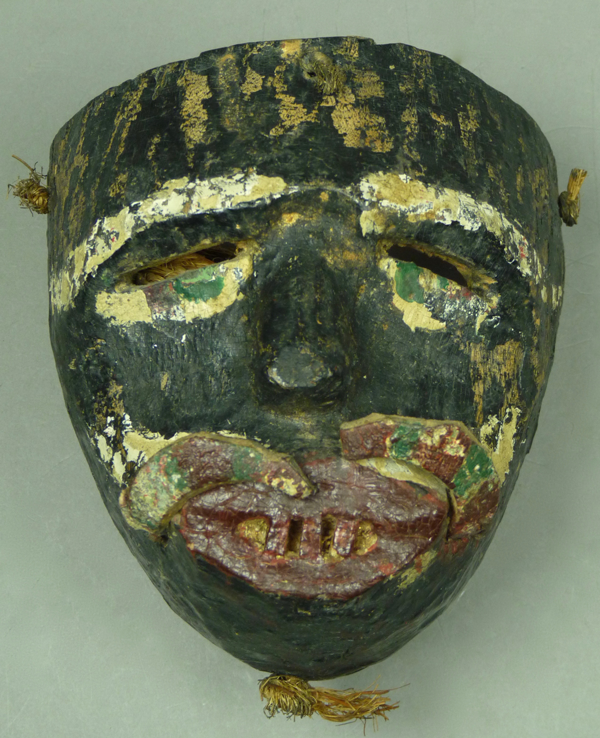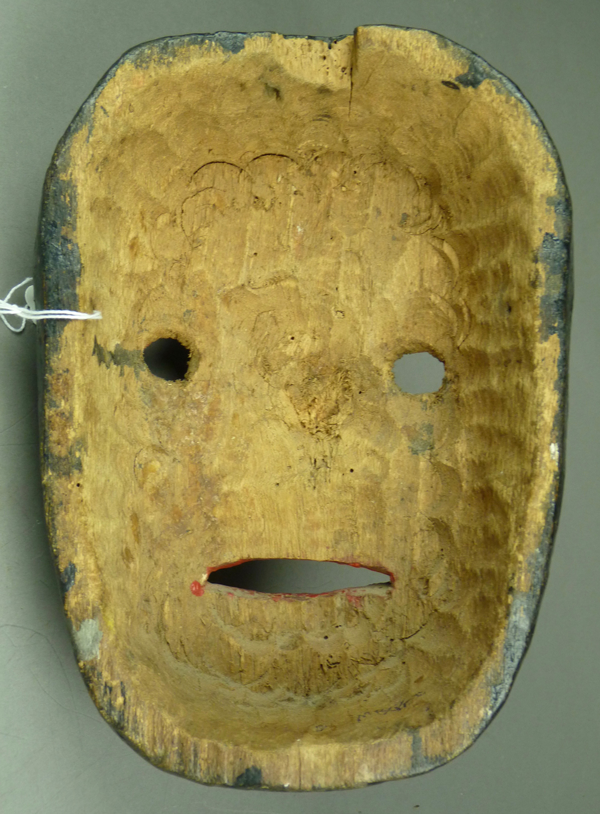Last week I resurrected some material from earlier posts in anticipation of some new arrivals that I am highlighting this week. Unfortunately the newcomers were delayed. Necessity being the mother of invention, this situation led me to an unusual strategy—I allowed you to encounter these masks from the same limited images that triggered my purchase of this group. Then when the masks did arrive, I added better photos to this post.
[February 12, 2020- Sure enough, the box containing six masks from Oaxaca arrived two days later, so I have added those photos. However, the box with the Tusked Negrito was further delayed by a Winter storm, arrived today (Friday, February 14).
I’m sure that my experience is familiar to some of you, that one arranges a purchase and then encounters the vicissitudes of delivery!
Here are the initial photos. The first reveals a typical Tusked Negrito mask from the Sierra de Juárez, with leather tusks. It closely resembles the pair in last week’s post, except that it appears to be more worn. It had been part of a mid-20th century collection in Oaxaca that was assembled by Rex and Lolly Marcum (which I had misspelled as Markham) of San Gabriel Etla, Oaxaca.
It looks worn and battered, doesn’t it. But these are rare masks, and it does seem to be complete and intact.
The back appears to have an unusual contour. It seems undamaged, and there may be a tag, hopefully with useful information.
Here are updated photos, after this mask had also arrived.
The paint on the face is extremely worn.
This is otherwise a typical Zapotec or Mixe Tusked Negrito mask. The leather tusks are easily seen in this view.
This mask is 5½ inches tall, 5 ½ inches wide, and 3¼ inches deep.
The expected tag was not there. The back does have an unusual contour, with a shelf at the chin that is shaped like an ocean wave. There is staining around the edges from use, while the rest of the back is far less stained. Nothing is written on the back. It appears to have its original strap, which includes a chin element as one often finds in the Sierra de Juárez.
The next photo reveals a set of six Negrito masks from the highlands of Oaxaca. I felt quite excited when I saw this group, because I have never seen this style before, and there seem to be masks for various roles within a dance performance, an unusual feature for Negrito masks. Usually a corps of Negritos will all wear a uniform mask design. The seller stated that none of these masks had tags, and she only knew that she and her husband had purchased them from the Rex Marcum collection, probably back in the late 1970s, and that they were from an unknown town in the Mexican State of Oaxaca. She added that they are carved from a light wood and that those masks usually came from the highlands east of the city of Oaxaca. This would suggest that these are Zapotec masks, or maybe Mixe, which is the same provenance that one would have expected for the Tusked Negrito that we just examined.
The two masks at the top left corner of the photo have teeth that remind me of the toothy mouths of Tusked Negrito masks. Will there be sockets for tusks?
The backs of these masks reveal great age, which is consistent with the history that these masks were probably collected in the mid-20th century, approximately 70 years ago.
All of these views have been augmented with better lit images, now that the masks have arrived.
Here is the mask with the most prominent nose, indeed a nose that was barely visible in the group photo.
What an unusual nose!
We see an old surface, numerous cracks and repaints.
There is a hole for a chin strap
This mask is 10 inches tall, 7 inches wide, and 5 inches deep.
There is moderate staining from use. We see flecks of green paint that has been painted over, on this mask and on most of the others.
The second mask also has a prominent nose. In the original photo, this was my favorite mask of the six. Now I like them all!
Still, I like this jovial grin.
This is another mask with an unusual nose.
We see more old cracks.
There are hoes for a chin strap.
This mask is 9½ inches tall, 7 inches wide, and 3¾ inches deep.
There is moderate to marked staining from use.
Five of the six masks have “Mexico” written inside, evidently for bringing the set across the border to the United States. Sadly, there is no mark to tell us anything else.
The third mask is one of a pair with toothy mouths.
In this case there are two rows of teeth and space between the teeth to admit air to the interior. Such a mouth looks like that on a Tusked Negrito mask, but there is no sign that this mask ever had tusks.
More ancient cracked paint.
There is a hole for a chin strap, and we even find a remnant of the old strap.
This mask is 9½ inches tall, 7 inches wide, and 3¾ inches deep.
There is moderate to marked staining from use.
The fourth mask has just one row of teeth.
There is no penetration at mouth level to the interior of the mask. In fact, this lack of opening is the norm for half of the masks.
Note the hole for a chin strap.
This mask is 10 inches tall, 6½ inches wide, and 3¾ inches deep.
There is marked staining from use.
The fifth mask is unexpectedly attractive.
This is a very boyish face, isn’t it?
“I can see you.”
Note the metal repair at the bottom of the mask.
This mask is 9½ inches tall, 6½ inches wide, and 4 inches deep.
There is moderate staining from use, Note the metal repair at the bottom of the mask, and the old handmade string of the strap.
The sixth mask has the greatest wear to the paint.
This is a jocular face.
Note the metal repair strip at the top, in photo that follows.
This mask is 9½ inches tall, 6¼ inches wide, and 3¼ inches deep.
There is mild to moderate staining from use. Note the metal repair strip at the top.
Next week we will examine the eighth mask from this shipment, which is very different from the seven in today’s post. My initial impression is that it is from one of the Mayan villages in Chiapas. Like those in the set of six, next week’s mask is rare and unusual, of a design that I have never seen before. I am hoping that viewers will step forward to better identify these six and the one in next week’s post.
Bryan Stevens






































